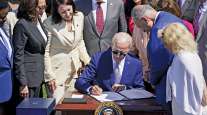Congress Returns to Work; Road-Fund Pressure Mounts
This story appears in the April 28 print edition of Transport Topics.
Lawmakers are scheduled to return to Capitol Hill on April 28 for just 43 days before their extended summer recess, giving them a short window to approve a long-term, comprehensive transportation funding bill.
The 2012 highway law, known as MAP-21, expires on Sept. 30, and transportation leaders are tasked with writing a new bill as well as figuring out how to keep the Highway Trust Fund solvent. Recent projections show the account, used to help states pay for infrastructure projects, running out of money by late August, mainly because a federal fuel tax is no longer enough to keep it operable.
Transportation Secretary An-thony Foxx last week said the White House soon would offer an official proposal for reauthorizing MAP-21. It would include a plan President Obama unveiled in March to use funds captured through an overhaul of the corporate tax system for shoring up the trust fund.
The president’s fiscal 2015 budget proposal includes $73.61 billion for surface transportation — a 1.8% increase over this year’s level — as part of an overall $302.3 billion transportation plan in the next four years.
“This bill will support millions of American jobs repairing and modernizing our roads, bridges, railways and transit systems,” Foxx wrote on his blog April 22.
There already have been a range of bills introduced in the 113th Congress aimed at boosting transportation accounts through tax incentives and infrastructure banks. However, none of them have advanced yet.
Last summer, Rep. Rosa De-Lauro (D-Conn.), a senior appropriator, unveiled a measure that would establish a government-owned corporation to fund infrastructure improvement projects. Rep. Nick Rahall (D-W.Va.), ranking member on the Transportation and Infrastructure Committee, has a bill that would provide $5.5 billion to reduce the backlog of the more than 150,000 structurally deficient and functionally obsolete bridges.
For months Rep. John Delaney (D-Md.), a first-term member of the House, has been promoting his bill that would establish a fund financed by private companies that repatriate cash held overseas. The fund would be supported by the sale of $50 billion worth of infrastructure bonds, which would have a 50-year term and pay a fixed interest rate of 1%.
Sens. Michael Bennet (D-Colo.) and Roy Blunt (R-Mo.) introduced a measure similar to Delaney’s that would establish a $50 billion infrastructure fund financed with multinational companies’ repatriated foreign profits. And Sens. Ron Wyden (D-Ore.), Jay Rockefeller (D-W.Va.) and Rand Paul (R-Ky.) also have separate infrastructure bills.
But rather than consider these bills, transportation observers interviewed by Transport Topics are convinced lawmakers will approve before the August recess a short-term infusion of several billion dollars for the trust fund and an extension of MAP-21 for the remainder of the year.
The legislative agenda in the House and Senate is crowded with other time-consuming bills related to wages, tax breaks and other issues. Traditionally, Congress tends to work at a slower pace during an election year as Republicans and Democrats try to build seats.
A former senior congressional staffer working with congressional committees on transportation said the parties will not put aside reelection concerns to craft and debate a comprehensive bill.
Ken Orski, a transportation analyst, agreed.
“As far as the pre-election prospects, I just don’t see how Congress will find the will to vote” on a reauthorization, said Orski. “What happens in the next Congress . . . depends, I think, on whether the Senate goes Republican or stays Democrat.”
The Federal Highway Administration estimates the country would need an annual investment of $20.5 billion to eliminate the bridge deficiency backlog by 2028. The current investments are about half that. According to Transportation for America, an advocacy group, 11% of all highway bridges are structurally deficient, meaning they require significant maintenance. And the American Society of Civil Engineers has identified thousands of other bridges in poor condition.
Two highway bridges have actually collapsed recently. In 2013, a bridge along Interstate 5 in Washington failed after it was struck. No fatalities were reported. In 2007, the bridge along Interstate 35 in Minnesota collapsed, killing 13 people.
Infrastructure advocates continue to underline the need for more spending on transportation networks. On April 24 the American Road and Transportation Builders Association listed the top 10 structurally deficient bridges in each state to highlight the need for federal funds for local projects.
“Congress needs to act immediately to get some additional revenues into the Highway Trust Fund to address that issue. Longer term for a solution, we have said we believe all options should be on the table,” said Alison Premo Black, the group’s chief economist.
Former Pennsylvania Gov. Ed Rendell (D), co-chairman of the advocacy group Building America’s Future, blamed lawmakers for not agreeing to a “bipartisan solution to our infrastructure crisis.”
Joshua Schank, executive director of the nonprofit Eno Center for Transportation, added that he is not all that optimistic Congress will come up with a long-term solution soon because if the 2007 bridge collapse in Minnesota “doesn’t focus your attention, what does?”




